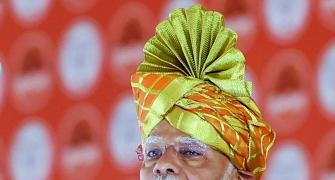Loan against gold as a product is catching on fast.
Let's keep the momentum going, but aim for sustainable growth.
A few bad apples should not ruin the brunch, argues Tamal Bandyopadhyay.

Early this month, the Reserve Bank of India directed IIFL Finance Ltd to cease and desist from sanctioning, disbursing and selling gold loans with immediate effect.
IIFL Finance, however, can continue with its existing gold loan portfolio and carry on the usual collection and recovery processes.
Why has the banking regulator taken such a step?
The RBI's inspection of IIFL Finance's gold loan book had revealed serious deviations in assaying and certifying the purity and net weight of the gold while sanctioning the loans and auctioning the yellow metal for recovering money from loan defaulters.
It had also found breaches in the loan-to-value (LTV) ratio, or the ratio of a loan against the value of the collateral (in this case, gold), given by the borrower.
The LTV for gold loans as personal loans is 75 per cent. The RBI had raised it to 90 per cent in 2020 after the outbreak of the pandemic for a period till March 2021.
Gold loans given for agriculture have always had 90 per cent LTV.
There have also been other regulatory violations, which affect the borrowers' interest and, in the process, the growth of the gold loan market.
Offering loans against gold -- a business that a handful of non-banking financial companies (NBFCs) in south India such as Muthoot Finance Ltd, Manappuram Finance Ltd and Muthoot FinCorp Ltd have been engaged in -- is now a popular product in almost every bank's portfolio.
The consumers, including those at the bottom of the pyramid, are open to monetising gold by taking loans from different financial intermediaries -- something that was taboo in the pre-Covid world.
The banking regulator is not alone in keeping a close watch on the fast-expanding gold loan market from its perch. The finance ministry is keeping it company.
In fact, a week before the RBI acted against the NBFC gold lender, the finance ministry's Department of Financial Services wrote to public sector banks, seeking a comprehensive review of the gold loan accounts opened since January 2022.
It has many concerns, including the quality of the collateral, interest cost and processing fees charged by the banks and early closure of many such loans.
It also wants to know whether the banks have been resorting to the evergreening practice -- giving fresh loans to borrowers to prevent an existing loan from turning bad.
The government and the RBI's action comes against the backdrop of a healthy rise in gold loans and gold price in the past one year (17 per cent and 16.6 per cent, respectively).
For the record, gold imports rose close to 134 per cent year-on-year at $6.2 billion in February.
With international gold prices at an all-time high, gold imports in the first 11 months of the current financial year have risen 39 per cent ($44 billion against $ 31.7 billion).
This trend is likely to continue. The February World Gold Council report succinctly explains what makes gold a strategic asset.
It is highly liquid, carries no credit risk and is scarce, historically preserving its value over time.
It also benefits from diverse sources of demand -- as an investment, a reserve asset, as gold jewellery, and as a technology component (it's a super conductor of electricity).
For an investor, all these attributes mean that gold can enhance a portfolio in three key ways -- offering long-term returns, diversification and liquidity.
India, the second-largest gold importer after China, is home to 14 per cent of the world's gold pile -- some 27,000 tonnes.
Close to 20 per cent of this, or 5,300 tonnes, has been pledged to raise loans. However, 65 per cent of this market is outside the formal financial system.
IIFL Finance had a gold loan portfolio of Rs 24,692 crore in December.
With a portfolio of Rs 66,000 crore, Muthoot Finance is the largest among NBFCs in the gold loan segment. Manappuram Finance's portfolio is Rs 20,809 crore.
The country's largest lender State Bank of India's gold loan portfolio in December 2023 was Rs 30,881 crore.
This is the quantum of gold loans given as personal loans. Its agriculture loan portfolio given against gold as collateral is Rs 1 trillion.
Bank of Baroda, Punjab National Bank, Indian Overseas Bank, HDFC Bank Ltd, Federal Bank Ltd and South Indian Bank Ltd are other banks with relatively large gold loan portfolios.
Apart from NBFCs and commercial banks, cooperative banks, Nidhis (a variation of NBFCs) and fintechs are crowding this segment.
Roughly, banks have 40 per cent of the market share and the NBFCs, 60 per cent.
Bajaj Finserv Ltd, a large and diversified NBFC, estimates that India's gold loan market, which was valued at $55.52 billion in 2022, will touch $124.45 billion by 2029, at 12.22 per cent compounded annual growth rate.
Let's look at the challenges before the lenders.
Once a person decides to take a gold loan, the first check by the lenders is the purity of the gold being offered as collateral.
They are willing to lend against 18 to 24 carat gold. While 24 carat is pure gold, 18 carat gold contains 75 per cent gold and 25 per cent other metals such as copper and silver.
Essentially, lower the caratages, lesser the gold.
Pure gold is soft in nature. Typically, copper is the preferred base metal to make gold stronger, harder and less brittle. It also acts as the best alloy to make ornaments.
The purity of the gold is checked by rubbing it on a black stone or scrapping it and using nitric acid.
But that's not always foolproof since very thick gold plating could be concealing another metal.
In such cases, cutting the gold piece or ornament is the only way to check its purity, but a prospective borrower would not like the idea.
While external experts ensure purity checks, frauds can be prevented only by asking the right questions when someone approaches a lender with stolen gold.
If they are not careful, the lenders will be left staring at an empty vault after the money is disbursed since the police would take away the stolen gold.
Typically, gold loans are given for a few months, or even a year.
However, most often, such loans are repaid ahead of maturity since not many borrowers are comfortable with long separation from this class of asset.
Mostly, it also carries a bullet repayment schedule, whereby the borrowers pay off the principal amount on maturity of the loan.
In case of defaults, lenders auction the gold after giving notices to the borrowers and advertisements in newspapers.
The lenders also need to keep a close tab on the price of gold.
In case the price crashes, the LTV of a loan already given rises and the borrowers would need to replenish gold collateral.
Despite these challenges, there are two key factors behind the lenders' enthusiasm for gold loans -- these loans are backed by full collateral and, since they are fully secured, banks do not need any capital to back such loans.
Since November 1962, when the first gold bond was issued, there have been many attempts to monetise gold.
It is finally happening with loan against gold as a product catching on fast.
Let's keep the momentum going, but aim for sustainable growth. A few bad apples should not ruin the brunch.
Feature Presentation: Aslam Hunani/Rediff.com
Tamal Bandyopadhyay is an author and senior advisor to Jana Small Finance Bank Ltd His latest book is Roller Coaster: An Affair with Banking
Disclaimer: These are Tamal Bandyopadhyay's personal views.











